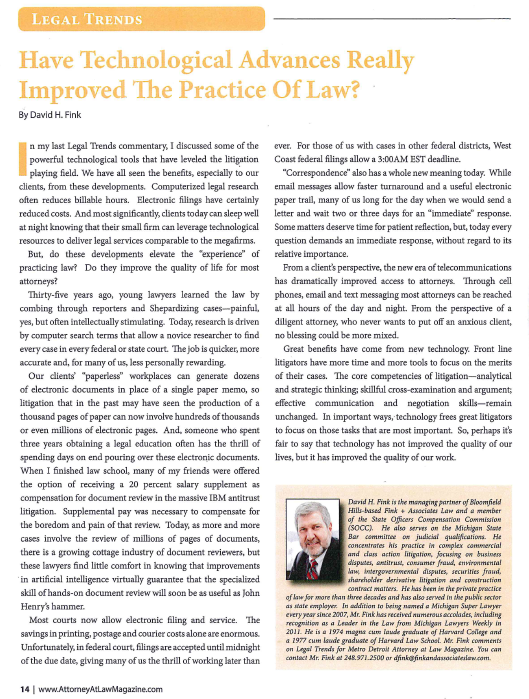Featured in Metro Detroit Attorney at Law Volume 2, No. 2, David H. Fink analyzes the benefits of new technology in the legal industry and whether or not new technologies actually improve the practice of law. To read David’s latest Legal Trends article, please click below to download a copy of the story, or scroll down to read the text of the article.
Have Technological Advances Really Improved The Practice of Law?

Have Technological Advances Really Improved The Practice of Law?
By: David H. Fink
In my last Legal Trends commentary, I discussed some of the powerful technological tools that have leveled the litigation playing field. We have all seen the benefits, especially to our clients, from these developments. Computerized legal research often reduces billable hours. Electronic filings have certainly reduced costs. And most significantly, clients today can sleep well at night knowing that their small firm can leverage technological resources to deliver legal services comparable to the megafirms.
But, do these developments elevate the “experience” of practicing law? Do they improve the quality of life for most attorneys?
Thirty-five years ago, young lawyers learned the law by combing through reporters and Shepardizing cases—painful, yes, but often intellectually stimulating. Today, research is driven by computer search terms that allow a novice researcher to find every case in every federal or state court. The job is quicker, more accurate and, for many of us, less personally rewarding.
Our clients’ “paperless” workplaces can generate dozens of electronic documents in place of a single paper memo, so litigation that in the past may have seen the production of a thousand pages of paper can now involve hundreds of thousands or even millions of electronic pages. And, someone who spent three years obtaining a legal education often has the thrill of spending days on end pouring over these electronic documents. When I finished law school, many of my friends were offered the option of receiving a 20 percent salary supplement as compensation for document review in the massive IBM antitrust litigation. Supplemental pay was necessary to compensate for the boredom and pain of that review. Today, as more and more cases involve the review of millions of pages of documents, there is a growing cottage industry of document reviewers, but these lawyers find little comfort in knowing that improvements in artificial intelligence virtually guarantee that the specialized skill of hands-on document review will soon be as useful as John Henry’s hammer.
Most courts now allow electronic filing and service. The savings in printing, postage and courier costs alone are enormous. Unfortunately, in federal court, filings are accepted until midnight of the due date, giving many of us the thrill of working later than ever. For those of us with cases in other federal districts, West Coast federal filings allow a 3:00AM EST deadline.
“Correspondence” also has a whole new meaning today. While email messages allow faster turnaround and a useful electronic paper trail, many of us long for the day when we would send a letter and wait two or three days for an “immediate” response. Some matters deserve time for patient reflection, but, today every question demands an immediate response, without regard to its relative importance.
From a client’s perspective, the new era of telecommunications has dramatically improved access to attorneys. Through cell phones, email and text messaging most attorneys can be reached at all hours of the day and night. From the perspective of a diligent attorney, who never wants to put off an anxious client, no blessing could be more mixed.
Great benefits have come from new technology. Front line litigators have more time and more tools to focus on the merits of their cases. The core competencies of litigation—analytical and strategic thinking; skillful cross-examination and argument; effective communication and negotiation skills—remain unchanged. In important ways, technology frees great litigators to focus on those tasks that are most important. So, perhaps it’s fair to say that technology has not improved the quality of our lives, but it has improved the quality of our work.


